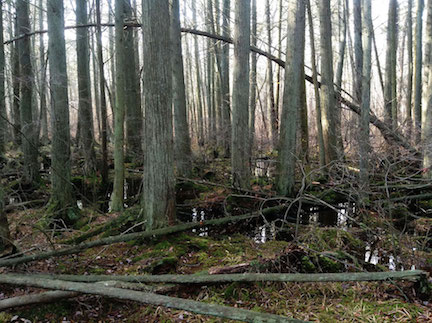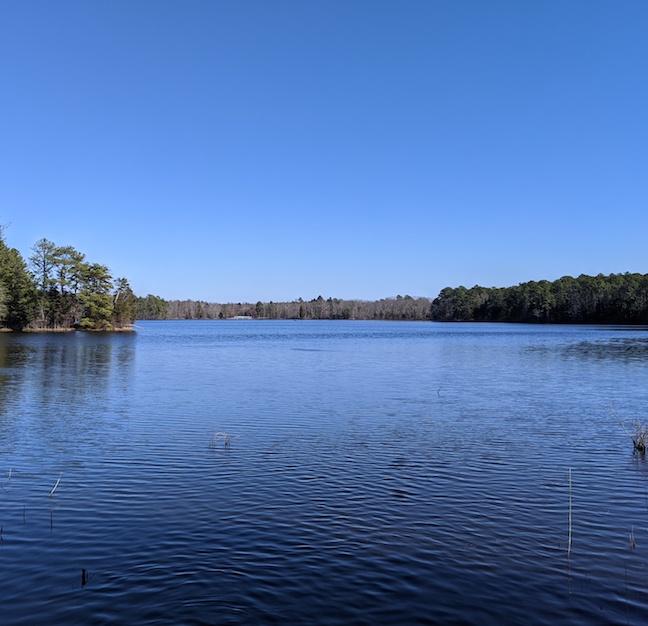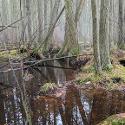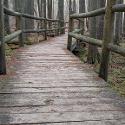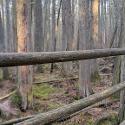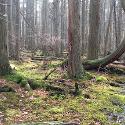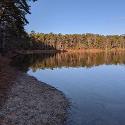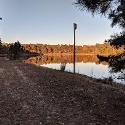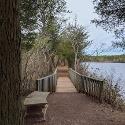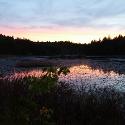Three Places to Visit on Campus
By Thomas Kinsella
At times I meet students—current or former—who have never ventured on campus beyond Stockton’s storied parking lots, hallways, food courts and classrooms. Some faculty and staff similarly have failed to explore their surroundings. This should not be. Our central campus is located on 1,600 lightly touched acres situated within the New Jersey Pinelands National Reserve, an area designated by UNESCO as an International Biosphere Reserve. There is striking natural beauty within short walking distance of the Campus Center. Let me suggest three places that all members of our campus community should visit at least once during their time at Stockton.
The Cedar Bog
One Pine Barrens legend tells of the Devil meeting Sammy “Buck” Giberson, the greatest fiddle-player of the Pines, on a bridge across a dark and lonely cedar swamp. The two squared off for a fiddling contest and Sammy was overmatched until he listened to the sound of the wind passing musically through the trees and, inspired, fiddled his version of “The Air Tune.” Walk out to the western side of Parking Lot 7, near its center point against the tree line, and see the obvious trail extending into the woods. Walk three hundred paces and find yourself at the Cedar Bog Bridge crossing Cedick Run (two hundred years ago, Smith’s Run). Fear not. Walk the bridge and enjoy the quiet green beauty of Stockton’s undisturbed cedar bog. If the wind is blowing, look up and listen. You might hear Sammy’s tune.
Lake Pam
Lake Pam is a borrow pit, dug when the Garden State Parkway was under construction in the 1950s and fill was needed for the roadbed. Gravel was borrowed, never to be returned, but the result was a gravelly-bottomed, aqua-colored pond. Once a favorite swimming and sunbathing spot for students and community members, Lake Pam is now frequented by deer, ducks and the occasional passerby. Approach the lake from the northwest via the dirt road across from Parking Lot 0 or from the southwest via the road across from Parking Lot 1. It is not difficult to imagine a former time, when sugar sand roads were plentiful and parking lots did not congest the landscape—when life’s demands were less pressing, measured not in battery life but in seasons.
Lake Fred
The early Stockton planners envisioned Lake Fred as an aquatic quadrangle at the center of the campus. The college would grow beside it, with academic buildings on the south shore and housing and student activities a short walk away on the north and west shores. Environmental concerns precluded building to the west along Cedick Run. Still much of our campus hugs the lake. A leisurely paced walk, starting from H-wing, takes 22 minutes to circumnavigate the lake. Cross the upper and lower lakes complex along the dark path, then follow the paved walkway past the housing courts, Lakeside Center, and arrive at the Light path, which crosses the outflow of the lake, connects with Lakeside Lane behind A- and D-wings, past the library, and then back to H-wing. The more adventurous will walk the well-marked paths closer to the lakefront, observing turtles, waterfowl and other denizens of nature. Before Stockton, Lake Fred was a cranberry bog, and, even earlier, it provided waterpower for a colonial sawmill. Watch a fire-red sun set, standing on the outlet bridge and looking westward. Walk the dark path in the snow or explore the small island close to G-court shore. The beauty of Lake Fred changes with the seasons. It is an exemplary center for our campus.
I wrote that these places should be visited at least once. Of course, they are worth visiting and revisiting many more times than that, and have been by generations of Stockton students.
Photos from Visits to These Three Places
